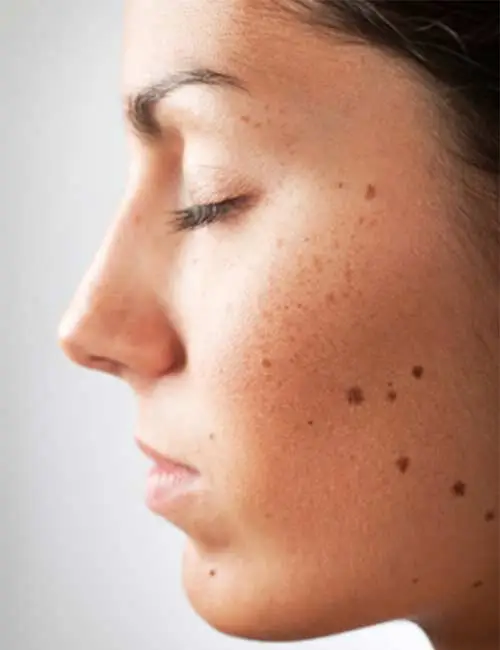Moles
Moles are common skin growths that may be flat or raised from the skin. They have a wide range of appearances. They may be skin colored to pink, a light tan brown and even blue-black. They may contain hairs. They can appear anywhere on the skin.
Although most moles begin to grow in infancy, new ones can develop at any age. Puberty and pregnancy are times when new moles may appear, and when existing moles tend to become darker and larger.
What causes moles?
Moles are benign growths of special skin cells that contain the pigment, melanin. Everyone has moles. Some of us have a lot, others have a few. The number depends on our genes. There is nothing that can be done to prevent their appearance, but something can always be done to treat or remove them if necessary.
Learn the ABCD signs of a ’bad’ mole or melanoma cancer. You can learn to recognize the signs of a bad mole. Learn the ABCD’s of melanoma:
- Asymmetry – one half doesn’t match the other half.
- Border irregularity – the edges are ragged and notched or blurred.
- Color – the pigmentation if not uniform; shades of tan, brown and black are present. Dashes of red, white and blue add to the mottled appearance.
- Diameter – greater than 6 millimeters (about the size of a pencil eraser). Some additional warning signs of melanoma would include changes in the surface of a mole’s scaliness, change in sensation including itchiness, tenderness or pain.
Get to know your skin and its moles by doing systematic self-examinations using a full-length mirror and a hand mirror. In this way you can best determine if there has been a change. If any mole appears suddenly or changes in color, shape or size or bleeds, it should be checked by a physician.
Although the great majority of moles are harmless, the above changes warrant examination by a physician.
Treatments
Most moles are harmless and safe to ignore. Once determined to be benign, there are only two reasons for removing a mole:
- A mole that is annoying or that is irritated by your clothing, comb or razor is only a nuisance and can be removed to prevent ongoing irritation.
- A mole that is unsightly can be removed for ’cosmetic reasons.’
If the reason for removal is simply because it is annoying or unacceptable cosmetically, the surgical treatment chosen must be the least aggressive and therefore the least scarring. When removing cosmetic lesions, as opposed to skin cancer, we would rather err on the conservative side, knowing that we can always remove more later if necessary. When using the conservative approach that will afford the best cosmetic results, there is a chance, albeit small, that a mole will return once it has been removed. If it does reappear, the patient should consult the physician.
Most procedures used to remove moles can be performed in the office. Bleeding is usually minimal. There is very little, if any, discomfort.
The most common methods of removal are:
- Shave excision whereby, after numbing the skin, the mole is removed flush to the skin.
- Excision of the mole with suture closure.
In either case you will be trading the mole for a flatter, whiter or paler scar with no hair that is much easier to cover with makeup.
With both methods, as a matter of course, the specimen removed is sent to a laboratory for microscopic examination.
Care of the surgical site: The scab (crust) that covers the surgical site is nature’s bandage, and healing takes place beneath the scab. The scab will fall off by itself when healing is nearly complete.
Please follow these directions:
- Let the site heal naturally if you can open to the air. It may take up to three weeks to completely heal.
- During the day you may cover the scab by applying a small amount of makeup.
- After 24 hours following the surgery you can wash your skin as usual, but it is best to try to keep the scab itself dry. You may get it wet temporarily, but gently dry the scab afterwards. When swimming, protect the scab with a Band-Aid. Be sure to remove the wet Band-Aid when you come out of the water.
- Keep the scab clean by dabbing it once or twice daily with a small amount of rubbing alcohol or hydrogen peroxide. Then apply a thin coat of Polysporin ointment (no prescription needed) to the site to prevent infection.
- Try to avoid activities that will irritate or traumatize the site. If this is not possible or if clothing irritates the area, provide temporary protection with a small dry dressing or bandage.
- If the skin around the site becomes red, swollen and painful, you may have an infection. Call this office promptly.





